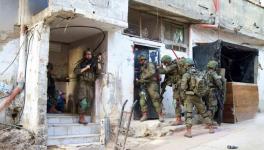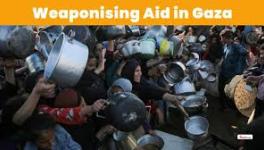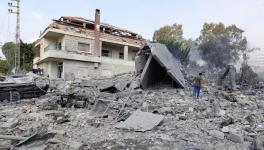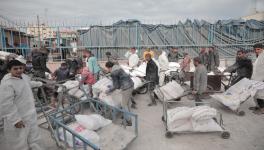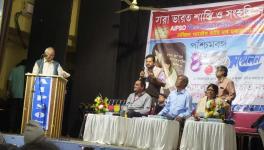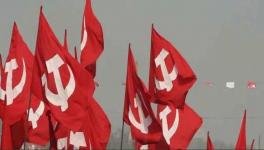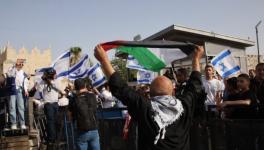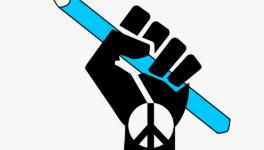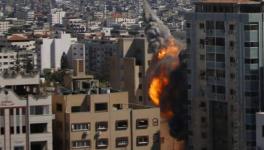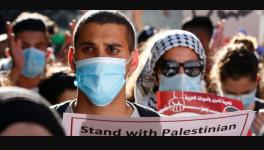The Children of Palestine
Directed by Mai Masri, Frontiers of Dreams and Fears revolves around Mona and Manar, two Palestinian girls growing up in refugee camps in Beirut and Bethlehem. Despite the overwhelming barriers that separate them, the girls form a close friendship through letters and a dramatic meeting at the Lebanese border. Shot during the liberation of southern Lebanon from Israeli occupation and at the beginning of the Palestinian intifada, the film articulates the feelings, hopes, and growing activism of a generation of young Palestinians living in exile.
After a recent online screening of the film with Vikalp@Prithvi, Mai Masri responded to viewers' questions in an interview taken and transcribed by Apoorva, a Palestine solidarity activist.
Apoorva (A): Thank you Mai for sharing this incredible film with us. It has moved so many people and we are looking forward to hearing from you about the process and have you answer some audience questions. We could start with one by Leeroy Mathias who asked how your experience of shooting in the refugee camps was.
Mai Masri (MM): It is good to talk to you and also, it is so close to the date when South Lebanon was liberated, on the 25th of May, 2000, and it is a very special day. And this film is a part of the process I started — I made a trilogy of films on Palestinian children. The first one I made was in Palestine called Children of Fire during the First Intifada, in 1989. Then I made Children of Shatila ten years later in the Shatila refugee camp in 1998, to mark the 50th anniversary of dispossession of Palestinians in 1948, and finally Frontiers of Dreams and Fears in 2000.
In each of these films, especially Frontiers and Children of Shatila, I attempted to see through the eyes of children. And these two films focus on Palestinian refugee children. With Frontiers of Dreams and Fears, the idea developed to also film children in another refugee camp in Palestine called Dheisheh, and seeing through their eye. With Children of Shatila, I gave them a camera and I was looking to see how they were reacting and dealing with their everyday life through the camera. At the time of filming Frontier, the internet was a brand new phenomenon. It really changed the lives of Palestinians because in refugee camps, and especially in exile, there is no communication with people living in Palestine. The internet allowed communication to start again and I thought that was an amazing idea because the children I had filmed before were starting to communicate with each other — the children in Shatila, and in particular a young girl Mona with another girl in Dheisheh refugee camp in Bethlehem. I thought it was amazing that they were meeting each other and becoming friends and I felt that was like a bridge connecting and sharing their experiences.
A few months after I started filming, South Lebanon was liberated and that was a huge historic event. Children were always talking and for Palestinians, the dream of return is always present, even if they were born outside of Palestine and we are talking about the third generation of refugees at least. But their sense of identity and belonging (to Palestine) is very strong. So the chance to film them on the border meeting each other was a very powerful experience, I can talk about that later. But the experience of filming in the camps themselves I wanted to work as well on the imagination of children and how they see their world. Their daily lives are so hard, the poverty and misery of the camps, but at the same time what drew my attention was their imagination.
Mona, I call her the poet of Shatila because of the way she talks and articulates, and she is not the only one. It is quite amazing to see how these children talk. They are much more mature than children I have seen in any other place because of what they experience and live through. And with Mona there was an added poetic dimension of describing her life at the camp — always talking about beauty, like dreaming of becoming a bird and not a butterfly because "butterflies are imprisoned". It is very difficult in the camps especially because there is a sense of being surrounded, besieged, confined. All the Palestinian camps, they are like prisons, especially the ones in Gaza. So, I worked on that idea: the imagination and poetic expression, contrasting it with the reality in the camp. Then I developed the idea with Manar, the other young girl in Dheisheh. It is also an interesting camp because it is one where the walls speak the history of the camp and Palestine, drawn on murals in the camp so this is very striking as well.
A: The art becomes a medium for people to assert that "we are here" and make themselves visible even if the world and its politics forgets them.
Maybe we can move to a similar question around children. This one's from Pradita Nambiar who wrote, "Dear Mai, Thank you for such a wonderful film. What I found interesting in the film is the conception of a childhood which is different from the modern western conception where children are confined to classrooms and removed from the real world of work, sexuality and politics. In this conception which is now being sold to the world children have to be protected which means insulating them from community and economic life. Their growth is measured in terms of their schooling. With this dominant discourse what has been the response of international policy makers like "The Convention on the Rights of the Child" with respect to the children of the region?"
The particulars as well as the larger idea, the "ideal" of what a childhood is worth reflecting on, especially when we see people feeling uncomfortable when children express political opinions. Especially children are not like that, they observe and think through things, which is also a mainstay of the film.
MM: The fact and the reality is that Palestinian children are not protected. They are exposed to occupation, to exile. It is not a choice, really. They have been exposed to horrific events — invasions, war, imprisonment in Israeli jails. That there is no safety or stability is their relality. They see their parents arrested and there are thousands of Palestinian children who pass through Israeli prisons and in the camps in particular they are even more exposed to this kind of violence, whether it is the camps in Palestine such as Dheisheh and other camps where there are Israeli patrols that attack almost daily and every night. So there is no stability whatsoever.
And in the camps in Lebanon also the experience of children has been very traumatic over the years. They have been exposed to sieges and massacres — there is the 1982 Sabra and Shatila massacre. Shatila is also a very powerful symbol, I think, of Palestinian suffering, but also of resistance, because it is the camp that was most targeted. I mentioned the massacre and also the camp was under siege for three years and completely destroyed by Israel more than once. And these children that I filmed, Mona and her friends, this group of young, teenage Palestinians between the ages of 12 and 14, these children in particular have lost one or both parents in either in Israeli bombardment or the siege of the camp. So they have all experienced loss. In the Palestinian context it is also important that the community is strong. The fact there is a common identity, a sense of belonging to Palestine, the common political struggle as well. They have kept the people together and also helped the children even though they have lost parents and grandparents and relatives, there is a sense of community that compensates. So they grow up before their age. Of course they are exposed, they are on the streets all the time, there is no room inside the houses, it’s dark and damp and narrow alleyways so they are always mingling, talking, learning in the camp. They are very bright children. It is very striking, the fact that they are so profound and bright and for their age they are so mature and they can understand even politics. The way they describe their reality, they understand exactly what is going on. But at the same time they are children, there is trauma too, there is a lot of emotion. Their emotions were very raw when I was filming them because there is also a lot of suffering. They deal with it, but it doesn’t mean it is a normal childhood.
You asked me also about the UN's CRC, a point I should address, because at the UN, there are many resolutions to support the rights of Palestinians. The right of return, is very obvious, and that has not been implemented or respected, there is Children’s Rights (convention). The UN agency that takes care of Palestinians, even that is under fire, the UN is itself under attack and international law is not being respected, there is a continuous breach of UN resolutions. And the UN is weak. Even if they pass resolutions they do nothing about it — they cannot. Their hands are tied and they don’t have the will or the power. This is the big problem and this leaves Palestinians exposed, especially children.
What is really shocking is the prisons. Israeli prisons are full of Palestinian children. I have seen how they are completely terrorised — arrested, 9-year-olds, 5-year-olds, and even 12-year-olds is common. And they arrest them in the middle of the night or 3 am and they are put in solitary confinement or they are put with Israeli criminal prisoners without any access to schooling. And this creates a lot of trauma. Palestinians have learnt how to deal with this but still the scars are deep on children. It is a very serious matter.
A: Yes, and the telling of trauma also makes it very real. The toll it takes is never fully understood by someone who hasn’t experienced it. There is a question of Anand Patwardhan’s which is more around the political context. He wrote, "It was wonderful to see your film again after a long time. I am struck immediately by how timeless and indestructible it is and how it will continue to touch anyone who has a heart and a brain. At the same time I’m aware of how much worse the situation is today for Palestinians (and for those Israelis who want peace with justice). With Trump’s USA nakedly giving in to everything Netanyahu demands, I’m pretty sure such a film would be hard to make again today. And yet the resistance goes on, so I’m sure you and others are still finding ways to tell these stories?"
This is something that is often asked by cultural practitioners — how does one operate and make films with so many growing restrictions? Just the fact that the key moment of the film, when Mona and Manar meet at the border, is not possible anymore.
MM: Yes. The resistance does continue and there are many ways to do that. The resistance at the time — the liberation of South Lebanon when I filmed this — these are historic moments that won’t be repeated in the same way. There are many acts of resistance all the time, even small acts, so it is ongoing.
But the images I took in 2000 are impossible to film now. Even at the time, three days after I filmed on the border, and those images were for me were maybe one of the most powerful experiences I have ever lived through because I was filming thousands of Palestinians who were flocking to the border on the Lebanese side from the refugee camps to see their land. To see the Palestine that most of the young generation had never seen, and the relatives from the other side, and that the children meet for the first time on the border, the barbed wire, that was almost miraculous because it is quite impossible for Palestinians inside occupied Palestine to move across the checkpoints and bringing those children from the Palestinian side was very difficult. But as a result, I felt different emotions — it was as if you are filming and history is happening in front of you — people crying, tears of joy and tears of hope, at the same time. And to be able to capture it as it happened, it is a way of writing history with the camera because without the camera those moments, if they are not documented, don't have the same impact. By documenting them you are preserving history, you are preserving memory, you are preserving all that hope. That is why I could really feel that moment.
But then after we filmed, a few days later, even the Israeli soldiers were overwhelmed by all those emotions. They felt the danger — you know it is a very dangerous thing for the occupier when the occupied have hope. This is even more dangerous than weapons. So they immediately stopped any kind of encounters at the border. It became a closed military zone and anyone who goes near the border was shot and killed. And many people have been killed since. There was also a march of return in 2011 and several Palestinians were killed, young Palestinians who went to the exact same spot where I was filming. One of them was my nephew who was wounded and paralyzed actually by an Israeli bullet. It is an ongoing suffering for all Palestinians.
A: Really sorry to hear that, Mai. We could come back to this scene if you feel okay talking about it. For anyone who has seen the film, the moment of the meeting is unforgettable. What stayed was the images of those children taking some of the soil of Palestine in cups. It is relatable to people anywhere who have been displaced from their homes. Indian subcontinent’s partition in 1947 has made this memorialisation of soil and home very close to our lives. In this scene though, it is these children, so many generations later, making that connection and carrying that memory.
Equally interesting is the inside worlds of these children — their homes, their rooms, balconies, their inner worlds. The care with which they preserve them is perhaps related to the violence and displacement outside.
MM: You know the idea of touching the soil of Palestine is very strong among Palestinian refugees, the dream of being able to hold the soil in their hands and keep it, is across the board with any Palestinian who has been uprooted from their land so the idea of the land and the home is very strong. The community is equally strong and that is how memories pass on from one generation to another — grandparents tell the children, and this is how the children know about their homeland. So if you ask Palestinian refugees where they are from, they don’t usually say I am from Shatila, they might say I live in Shatila but they always connect to their original villages in Palestine.
And they keep that memory alive in many creative ways — partly through their own imagination like Mona or the activities like keeping the dance, the Palestinian customs and culture alive, the very strong bonds within families and even the camps are organised like the village used to be. The clans that live in the camps are the same ones that used to live together in their original villages in Palestine. And they solve their problems and have their own kind of codes and laws in the camp. And each camp has its own experience, of course.
Another very touching moment was when Mona asked Manar to visit her village in Palestine and send her some of the earth from the village, and I am going back and forth, taking the letters. So Manar visits Saffuriya which is a beautiful village where Mona comes from, and Saffuriya is a destroyed village. And this opens up another layer because there are different layers to the film. The occupied Palestinian villages that were destroyed, and there are over 500 of them, by Israel in 1948. They either built on top of them or they destroyed the remnants even. You can’t see much left except some cactus. They could not uproot that so there are some stones and cactus left but wherever, as Manar tells Mona, you see cactus you know there was a Palestinian village there. That is also a very powerful moment.
And so this whole movement of youth now, talking about Palestinians refugees within Palestine, they are trying to reclaim their history because the names of the villages were changed. So they try to visit their villages of origin and try to keep that connection alive or they do marches in the camp where they carry keys, the symbolic key. Many Palestinians kept the key of their homes in the hope that they would return so that you sometimes find an old key, the big iron key, hanging (on the walls) and this is very symbolic as well.
A: It is very moving, talking about this. This is where the idea of memory being resistance comes alive. Something that we saw in the 2018 return march in Gaza where people would say that I can see my village across the barrier but I can’t go there. It is impossible to be unmoved, listening to these stories of connectedness to a place you can’t touch or go back to, and keep struggling even when the borders are closing in so tightly around you.
MM: Totally, and you need to tell the stories because you need to understand each individual’s story and it is about the narrative too. Because this is a struggle to tell the story, to keep the narrative- because also this is (about) who controls the image, who tells the story. And Palestinians really haven’t had the opportunity for a long time to tell their own story and this is another form of resistance- when you own your story and your narrative and you are able to tell it to the world because the world is– you know it is hard to move people. You really need to humanise and tell your story and this is more than politics, it is about humanity. You told me about the Indian audience being touched- I know, because there are some themes that are so universal and especially in countries where people have also suffered. They know what oppression means, they know what losing rights and struggling (means). They can understand the emotion and they can understand these themes without having to explain all the politics.
A: I love what you said about owning the story, and this is true for a lot of places but I have to say that this is especially true for Palestine maybe because of the international attention. But to date, the distortion of the narrative and dehumanization of Palestinians is rife in western media. They tell the story from the wrong side always, blaming Palestinians, etc. This is why telling the story in your own voice is so important.
MM: Yeah. Because the whole narrative of Palestine is full of- the way it has been depicted from the beginning- the Zionist propaganda from the beginning was, and is till now, that “Palestine was a land without people, for people without land”. I mean Palestine was full of people and even the images- this is where we come back to the power of the image- the first films that were shot in history, when they were still shooting Black and White in the 1930s or even before, they shot footage in Jerusalem, in Yaffa, showing the marketplace, you could see how lively it was- the mosaic of the society. This is very valuable. There is a whole attempt to confiscate and steal and hide it. There is even a film called Looted and Hidden by an Israeli woman. She was able to make a film about the Palestinian archive of films which was stolen by Israeli army in 1982 when they invaded Beirut and they stole it. When others tell the story, they distort it, not just Israel, I mean, the western media you mentioned. It is always about Palestinians attacking Israelis or it is just about the violence. It doesn’t show humanity or everyday life or the rich cultural life- it doesn’t show any of these stories.
A: I just want to circle back to one point mentioned earlier and stop there even though I do want to listen to you a lot more. You mentioned how weak the UN is, and it is also about how we have allowed it to be so. In the last century, newly liberated countries from the global south pushed that institution to take strong positions. Today we cannot have that hope from governments and regimes which are so right wing and anti-people. How can a people’s solidarity emerge from this moment and challenge this global order?
MM: This is important, because even when we try to tell our stories- it is hard to get our films distributed even if they feature in big festivals. But when it comes to distribution, there is a block in many countries usually for political reasons because Palestine is such a sensitive subject. So it is important to find other ways and now with the internet, communication, the possibility of putting work on digital mediums- it breaks the siege. I mentioned how in 2000, the internet was big and it really allowed Palestinians to break the siege particularly in places like Gaza which has been besieged for more than 10-20 years. It is important to create connections with other grassroots organizations around the world and also see the intersectionality of struggles. It is striking to see how similar the oppression is in many countries. Maybe Palestine is a bit specific in the sense that it is settler colonialism and is more similar to South Africa. But the violence of occupation, you can see it everywhere, even in the US now with what is going on, with Black Lives Matter. The way violence is being committed against people is so similar, it is shocking.
And there are a lot of connections — Israeli forces training a lot of police forces around the world and especially in the US. So there is a lot of intersectionality between struggles and also the oppressions. So it is important to create stronger connections. In the past there were such movements, and it is time to renew those. In the 60s, 70s and 80s it was the liberation movements, which allowed for automatic solidarity with Palestine and you had many solidarity groups coming. But it is a different world today and there are other kinds of connections that can be made. The Jewish groups that are pro-Palestine are more aware and active in the US. But the Israeli left is weak, there is no opposition.
A: You have really illuminated an important part of our work, as we have been highlighting the fact that Indian government buys 50% of Israel’s arms exports, and borrowing surveillance technology as well as ideological frameworks — whether it is Kashmir or against minorities all over. And I guess this message of intersectionality is the one we must preserve and is the one to conclude this conversation with. This also allows us to break the stagnancy of solidarity and allows us to think of a more original and grassroots way of thinking, connecting what is happening from the US to Palestine to India. Indeed Israeli forces train US police in various states, they have been working with Indian army and police too. So they have been working together a long time and it is on us to end this isolation of struggles and develop this connectedness. That would be the perfect way to conclude.
MM: Yes, and I feel very positive and optimistic because we have a very powerful tool which is culture and art, and it is another way to activate groups and build bridges and get people to be more involved. So we need to work hard and keep making films, writing books, painting and music.
A: Absolutely, thank you very much Mai. We must get together and see another of your films and talk again. It is incredible, the film and everything around it and we need to hear more from you!
Get the latest reports & analysis with people's perspective on Protests, movements & deep analytical videos, discussions of the current affairs in your Telegram app. Subscribe to NewsClick's Telegram channel & get Real-Time updates on stories, as they get published on our website.









